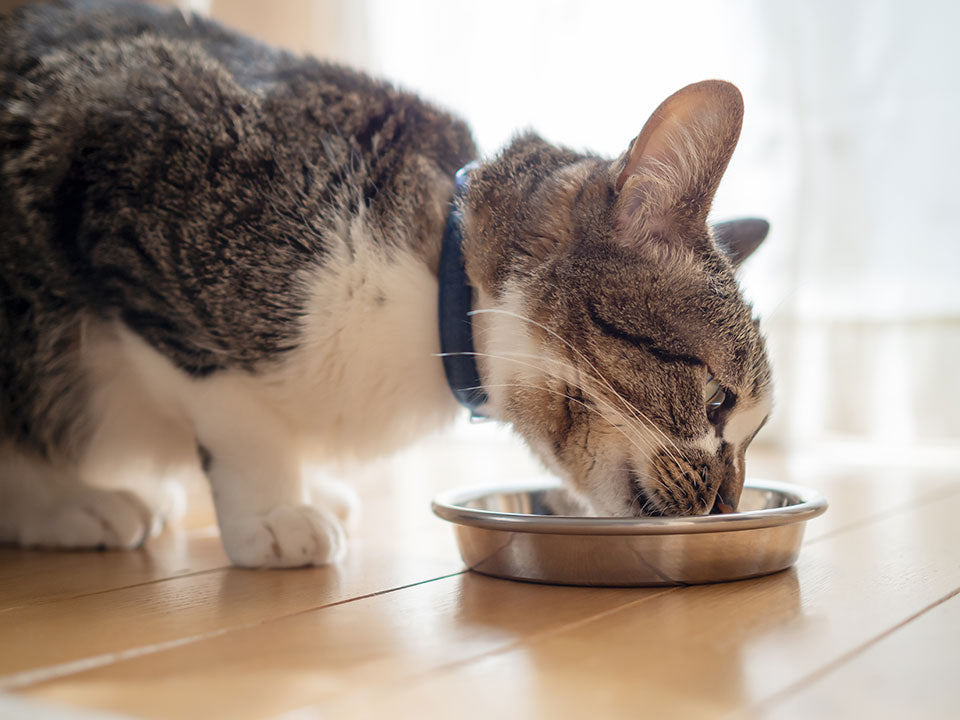You are your vet’s eyes and ears between visits. And cats are experts at hiding sickness or injury. That’s why it’s important to look for warning signs and monitor your cat’s health at home.
Five Tips to Track Your Cat’s Health Between Vet Visits
Check That Your Cat’s Body Weight Is Healthy
Weigh your cat each month and confirm with your vet what a healthy weight range should look like. Ask your vet how much weight fluctuation is considered normal for your cat and give them a call if you start seeing larger changes on the scale than expected. If your cat doesn’t like to stand on the scale, try holding them and subtracting your weight from the total.
Also check their body for signs of weight gain or loss, first visually and then physically. Stand above your standing cat and look down; you should be able to see a slight waist behind their ribs. Next, place both hands gently on your cat’s ribs. Generally, if your cat is at a healthy weight, you will be able to feel (but not see) them easily. This exam is also a good time to check for pouches of fat in the groin area, between the hind legs and under the belly.
Examine Your Cat’s Skin and Fur
Your cat's coat can tell you a lot about their overall health; their fur should feel uniformly smooth from head to tail. If your cat has a dull or matted coat, talk to your veterinarian about what might be causing it, and ask if changing their diet could help.
It’s easier to check on your cat’s skin if you part their fur first. Use a comb to make a part down the middle of their back to check for any signs of trouble. It’s also important to check for fleas (especially at the base of the tail and on the rump and stomach).
Take a Look at Your Cat’s Ears and Eyes
Your cat's ears should be clean, light pink and free of debris or strong odors. Take a look around for anything unusual, especially dark wax, which might be a sign that it’s time to call the vet. They can take a close look and make sure your cat’s ears are feeling fine.
To examine their eyes, gently pull down each of your cat's lower eyelids — this area should be pink and the whites of their eyes should be glossy white. Their pupils should be a normal size and responsive to light (but don’t shine your flashlight straight in their eyes; no one likes that!).
Give Your Cat’s Whole Body a Physical Exam
It’s important to have an idea of what’s normal for your cat’s body. Frequent petting is nice, but specific attention to the feel of their form is the best way to check for changes. Start by placing both of your hands on top of your cat's head and move them down under their chin, feeling for differences as you go. Then use the same pattern to examine all their hard-to-reach places — inspect behind their front legs, under their shoulders, down their back, over their hips and down their legs.
Pay attention to that pedicure too — carefully examine their claws and foot pads for any signs they’ve been playing too hard or need a little extra paw care.
Check Your Cat’s Teeth and Gums
Take care of that feline smile! A great way to take a good look around in your cat’s mouth is doing a feline flip-lip test for their overall oral health.
Check their gums with the press of a fingertip — lift your cat's lips away from the gums and press a finger firmly over an upper tooth. When you take your finger away, the white color of the finger imprint on the gum should return to pink.
Next, take a look at their teeth. If you notice buildup or any discoloration, it’s time to call the vet and get their expert opinion. A daily FELINE GREENIES™ Dental Treat is a great way to help reduce tartar and establish a daily at-home dental-care routine for your cat.
Help Your Cat Take Medication
Vets may recommend medication for all kinds of reasons. Making sure your cat takes their meds on schedule is an important part of supporting their overall health. If they need to take a pill and they’re hesitant about eating it, you can help your cat take their medication. A FELINE GREENIES™ PILL POCKETS™ Treat can be just what the doctor (or in this case, vet) ordered.
Your cat relies on you for help staying healthy and happy at home. By making sure they get the professional care they need and checking on their health at home, you’ll be building a stronger bond while supporting their long-term health.

